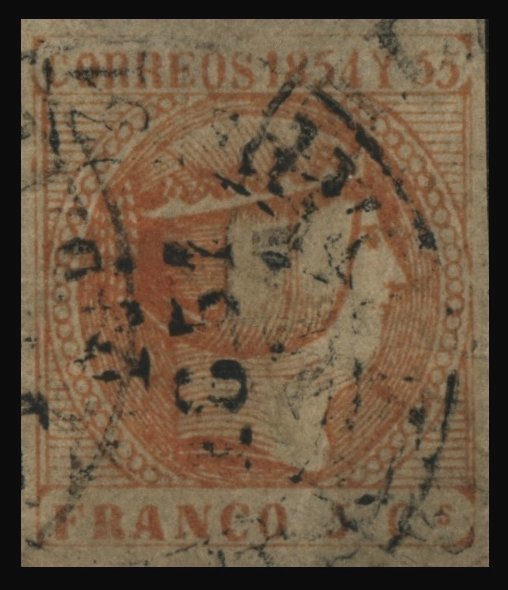|
Gooding #1F1
Bartels #C1.1; Earee First Forgery (Page 206)
Engelhardt Fohl Forgery. Engraved in Taille-Douce in yellowish stout, moderately soft buff
wove paper. All the date numerals are as tall as 'CORREOS' and 'Y'. The ink
stands out in ridges on the surface of the paper, the depth of the lines
being much exaggerated. The '5' in '1854' has a very short top line. One or
two of the pearls below the 'Y' are shaped like a 'D'. Also known with Double
Impression. (Same die as Gooding #2F2, 4F2 and 5F1).
|

|

(Double Impression)
|
Gooding #1F2
Bartels #C1.2
Lithographed in orange-red, much the colour of the genuine, on
rather stout, very hard yellowish white wove paper. The 's' of 'Cs' is like a
'5' and a considerable distance from the 'C'. The ink does not stand out at
all from the surface of the paper. Known unused and used with bogus Baeza (16
January 1851) circular date stamp.

Gooding #1F3
Printed in Orange.
'5' in '1854' is taller than the other numbers. Second '5' in '55 is very
narrow and has virtually no loop. The bottom loop of '5' in '5 Cs' ends in a
dot.

Gooding #1F4
Crude imitation in red with coarse lined background. Letters and
numbers are of even size. 'FRANCO' is well away from the left frame line. Known
used with Arana cancellation. Probably produced in Spain.

Gooding #1F5
Issued in red-brown. The 'Y' in the top description is
positioned to the left and touches the '4' in '1854'. No evidence of the
circle of pearls on the top left corner. Known used with a forged Small Baeza
circular date stamp.

Gooding #1F6
Earee Second Forgery (Page 207)
Lithographed in orange-red, much the color
of the genuine, on rather stout, very hard yellowish white wove paper. The
figures '185' of the date are all barely half of the height of 'CORREOS Y',
and the '4' is still smaller; so that the whole date seems to be sloping down
to the right, instead of level. The 's' of 'Cs ' is like a '5'. The
trefoil-ornaments on the coronet are very small, and only two of them show
the ring in the center. The coils of hair at the back
of the head are extremely faint and indistinct; there appears to be three of
them. The ink does not stand out at all from the surface of the paper. (Same
die as Gooding #2F8).
No picture
available.
Gooding #1F7
Issued in
red-brown. Letters and numbers at top are of even size. 'FRANCO' is very far
from left margin and the 's' in 'Cs' is away from
the right margin. A crude forgery. Known with a bogus circular cancel,
showing a mirror image of '5' in the centre.

Gooding #1F8
A
rather crude forgery on very thin (0.035mm) paper in soft blue. The '5' of
'1854' resembles a '3'. 'FRANCO' is too far from the left margin. '5' of '5
Cs' is crude and also resembles a '3'; and the 'C' is broken at the bottom
with no upward curve.

(Provenance: Carl Walske Collection)
Gooding #1F9
Very
crude forgery issued in yellow-orange. Lettering on top margin is small, in
particular the 'C' and 'O' of 'CORREOS'. The '5' of '1854' is much smaller
than the other numbers. The coronets on the crown are over-inked. Known used
with bogus Large Square Dotted cancellation.

Gooding #1F10
Printed
in black on salmon coloured paper. The 'F' of 'FRANCO' is distant from the
left side and has a small dot in the bottom half of the vertical stroke. The
upper line of '5' in '5 Cs' is short. Used with bogus cancel.

Gooding #1F11
Printed
in yellow-orange. Lettering on top and bottom tablets printed low, almost
touching the bottom frame line. The vertical staff
of the '5' in '5 Cs' is short and slanted right. The spacing between the
letters of 'FRAN' in 'FRANCO' are farther apart than
the other letters.

Gooding #1F12
Crude
forgery printed in deep salmon, inconsistent colour compared to the genuine
stamps issued in shades of orange. Even small lettering on top and bottom
tablets. The '5' in '1854' resembles an 'S'.

|
![]()
![]()
![]()
![]()
![]()
![]()
![]()
![]()
![]()
![]()